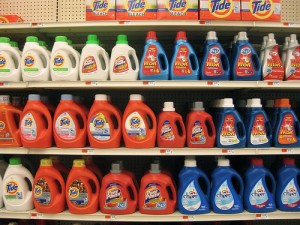I’ve been spending a lot of time recently thinking about what I’ve decided to call the “omnichannel spectrum”. The concept is simple. As a general rule, the creative investment brands make in the stages of the conversion funnel are inversely proportionate to the likelihood of conversion at that stage. Simply put, the further away an experience is from the moment someone actually makes a purchase, the more rich the creative customer experience is. Think about it, TV and social media generally get the most attention in terms of creative ideas that get people’s attention, engage them, and then allow them to share that experience. But we also know that TV ads and social have the least directly trackable ROI.
Now, I’m not saying that these media should be less creative. These are ways to get your message out there, increase recall, and ultimately increase chances of establishing brand affinity when it comes time to purchase. I applaud the vibrant, playful and sometimes interactive nature of these ad formats. $4M for a 30 second spot at the Superbowl would tell us that brands have data to support that this investment makes sense for them.
But let’s look at the opposite end of the spectrum: the point where 94.5% of all retail sales are happening in the US today: the offline retail store.
Yes, that’s right, 94.5% of sales are not occurring online. So as much as we with a digital marketing background love to talk about the growth rates of online commerce, the reality is that customers still love to touch, taste, and experience product in brick and mortar stores. This is where it gets curious.
Walk into a store and look for the product you want to buy. Chances are that today it is sitting there in front of you. Is it in a box? On a shelf? Hanging on a rack? Notice these questions. I didn’t ask whether the product spoke to you, made you laugh, inspired you, allowed you to have a conversation with it. But this is the moment of truth. Having seen that $4M ad while watching the Superbowl for Tide, you go to social media and have amazing conversations with … a detergent.
http://www.womma.org/blog/2013/03/how-tide-turned-laundry-into-a-social-event-for-everyone
And man, now that you laughed and talked with Tide, you’re a brand advocate ready to buy, buy, buy. People are so in love with this brand that they would trade it for crack, no really, you can.
So you go to your local grocery store and find the right aisle and you’re so excited to get some of that detergent that you love so much. And after all this work of brand marketers, neuro scientists, creatives and social media marketers, you finally get to actually experience the product behind all of these associations in the physical world. What you get in that moment of decision is this: 
You’ve laughed with this brand idea, you’ve shared moments with it and now its time to consumate the marriage. But wait … what was that? An item is interacting with you in the store and distracting you. But… its only supposed to be shelves of items.
“Touch me” says Gain from the next shelf over. “Touch me to see what happens.”
This isn’t right. I mean, I’ve already been dating Tide. We shared things and had conversations.
“But Tide isnt talking to you right now, I am” says the Gain display.
Listen Gain, you just don’t get me. But OK, it can’t hurt to just see what happens if I try you once.

Wow! Oh, and if I share this on my phone I get 5% off? Well, maybe I’ll buy you, just this once. I mean, after all I’m sure you can’t be that bad.
Personalization of the physical world is coming. It will be in your mall, in your home and yes, on aisle seven of your local grocer. If you think that all it will help you do is build your grocery list and find items in the store, start thinking much bigger.
The experience in a physical store will become the new and most important creative battleground to create brand loyalty and purchases. Ready? The omnichannel spectrum will level the playing field. Brand experiences will be more important in the store. How do brand prepare for this transition?